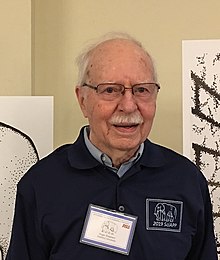셰퍼드 테이블
Shepard tables쉐퍼드 테이블(쉐퍼드 테이블 상판 착시라고도 함)은 스탠포드 심리학자인 로저 N에 의해 1990년에 "테이블을 뒤집는 것"으로 처음 출판된 착시 현상이다. 셰퍼드는 그가 [1]창조한 환상의 모음집인 그의 책 마인드 시즈(Mind Sightes)에서 나왔다.이는 가장 강력한 착시현상 중 하나이며, 일반적으로 길이 오산을 [2]20~25% 발생시킵니다.
심리학 사전을 인용하자면, 쉐퍼드 표 착시 현상은 "두 표의 상단을 나타내는 한 쌍의 동일한 평행사변형을 근본적으로 다르게 보이게 한다" 왜냐하면 우리의 눈은 3차원 [1]물체에 대한 규칙에 따라 그것들을 해독하기 때문이다.
이 착각은 90도 회전하는 것 외에는 동일한 두 개의 평행사변형을 그린 것에 기초한다.그러나 평행사변형이 테이블톱으로 표시될 때는 3차원 공간의 객체로 보입니다.하나의 "테이블"은 길고 좁아 보이며, 그 긴 치수는 멀리 떨어져 있다.다른 "테이블"은 거의 정사각형처럼 보이는데, 그 짧은 치수를 단축으로 [3]해석하기 때문입니다.MIT 인지과학 백과사전은 이러한 착각을 [4]"시선을 따라 주관적으로 가까운 차원을 확장시키는 크기와 모양의 항상성"의 효과로 설명한다.그것은 쉐퍼드 표를 "크기의 [4]환상"의 범주에 속하는 기하학적 착시 현상의 한 예로 분류한다.
셰퍼드에 따르면, "지적 수준에서 우리가 얻을 수 있는 환상에 대한 어떠한 지식이나 이해도 [5]환상의 크기를 줄이는데 사실상 무력하다."자폐 스펙트럼 장애를 진단받은 아이들은 전형적으로 발달하는[2] 아이들보다 셰퍼드 테이블 착시현상에 덜 민감하지만 에빙하우스 [6]착시현상에 똑같이 민감하다.
Shepard는 1981년에 "병렬도 착시"라고 더 일찍, 덜 강력했던 착시 현상을 설명했었다(Perceptual Organization, 페이지 297–9).[1]착시 현상은 동일한 [7]평행사변형이 아닌 동일한 사다리꼴을 사용하여 구성할 수도 있습니다.
쉐퍼드 테이블 상판 착시 현상 [8][9]변형은 2009년 "올해의 최고의 착시 현상"으로 선정되었다.
크리스토퍼 W. 타일러는 특히 [10]환상에 대해 학술적인 연구를 했다.
레퍼런스
- ^ a b c Colman, Andrew M. A Dictionary of Psychology (3 ed.). Oxford University Press. ISBN 9780191726828.
The illusion was first presented by the US psychologist Roger N(ewland) Shepard (born 1929) in his book Mind Sights: Original Visual Illusions, Ambiguities, and Other Anomalies (1990, p. 48). Shepard commented that ‘any knowledge or understanding of the illusion we may gain at the intellectual level remains virtually powerless to diminish the magnitude of the illusion’ (p. 128).
- ^ a b Chouinard, Philippe. "The Psychology of Seeing in Autism". La Trobe University. Retrieved February 11, 2019.
[The Shepard tables] illusion is one of the strongest optical illusions that exists, on average the apparent size difference is 20–25%. Our preliminary work and earlier work performed by others (Mitchell, Mottron, Soulieres, & Ropar, 2010) reveal how susceptibility to this particular illusion is diminished considerably in persons with an ASD.
- ^ Shapiro, Arthur Gilman; Todorovic, Dejan (2012). The Oxford Compendium of Visual Illusions. Oxford University Press. p. 239. ISBN 978-0199794607.
For example, the famous Shepard tabletop illusion (Shepard, 1981) is more convincing when the planes are embedded in box shapes than when they are presented in isolation.
- ^ a b Wilson, Robert Andrew; Keil, Frank C (2001). The MIT Encyclopedia of the Cognitive Sciences. MIT Press. pp. 385–386. ISBN 978-0262731447.
size and shape constancy subjectively expand the near-far dimension along the line of sight to compensate for geometrical foreshortening.
- ^ Shepard, RN (1990). Mind Sights: Original visual illusions, ambiguities, and other anomalies, with a commentary on the play of mind in perception and art. W.H. Freeman and Company. p. 128. ISBN 978-0716721345.
Because the inference about orientation, depth, and length are provided automatically by underlying neuronal machinery, any knowledge or understanding of the illusion we may gain at the intellectual level remains virtually powerless to diminish the magnitude of the illusion.
- ^ Landry, O.; Royals, K. (May 9, 2018). Illusion Strength and Associated Eye Movements in Children with Autism Spectrum Disorder While Viewing Shepard and Ebbinghaus Illusion Displays. INSAR 2018 Annual Meeting. Rotterdam: International Society for Autism Research.
The children with ASD (M = .14, SD = .10) were less susceptible to the Shepard’s tabletops illusion than the typically developing children (M = .20, SD = .05), t (28) = 2.41, p = .043.
- ^ Martinez-Conde, Susana; Macknik, Stephen (2017). Champions of Illusion: The Science Behind Mind-Boggling Images and Mystifying Brain Puzzles. Farrar, Straus and Giroux. p. 46. ISBN 978-0374120405.
Photocopy this page and then ..cut around the trapezoid shapes…The effect is a version of the classic Shepard Tabletop illusion.
- ^ Phillips, David (October 14, 2009). "Shepard's tables – What's up?". OpticalIllusion.net. Retrieved February 10, 2019.
Recently Lydia Maniatis pointed out a puzzling aspect of the illusion, in her prize-winning entry for the Illusion of the Year Competition.
- ^ Maniatis, Lydia (2009). "Another turn: a variant on the Shepard tabletop illusion". Best Illusion of the Year Contest. Retrieved February 10, 2019.
The three pink- and blue-colored parallelograms are the same. All blue lines are equal in length; all pink lines are also equal. Box B is simply Box C rotated counterclockwise. But the three parallelograms look different, and boxes B and C look different.
- ^ Tyler, Christopher W (May 19, 2011). "Paradoxical perception of surfaces in the Shepard tabletop illusion". i-Perception. 3 (3): 137–141. doi:10.1068/i0422. PMC 3485780. PMID 23145230.
One of the most profound visual illusions .. is the Shepard tabletop illusion, in which the perspective view of two identical parallelograms as tabletops at different orientations gives a completely different sense of the aspect ratio of the implied rectangles in the two cases (Shepard 1990).
외부 링크
- 환상의 애니메이션.Opticalillusion.net 를 참조해 주세요.
- Roger Shepard의 더 많은 착시 현상




